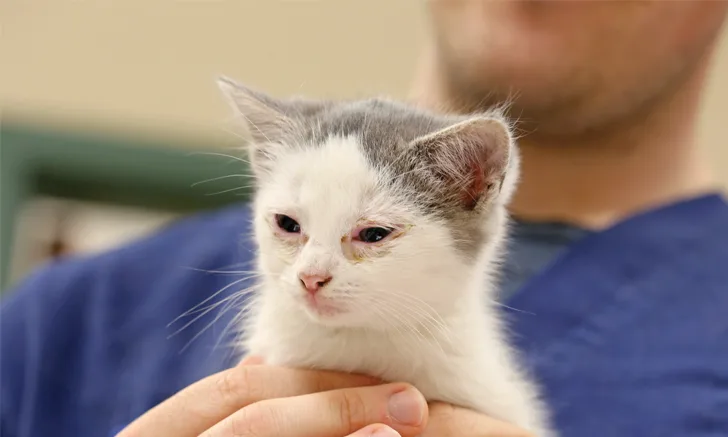Chlamydophila felis
Kimberly Woodruff, DVM, MS, Mississippi State University
John M. Thomason, DVM, MS, DACVIM (SAIM), Mississippi State University

Overview
Chlamydophila felis is an intracellular, gram-negative, rod-shaped coccoid bacterium capable of infecting cats of all ages, but cats <1 year of age are at greater risk for infection.1 Recently, a nomenclature change was proposed to classify all Chlamydiaceae species in a single genus, Chlamydia,2 with C felis specifically adapted to cats.1 Transmission of C felis infection requires close contact between cats because the organism does not survive outside the host.1 Therefore, the prevalence of infection may be greater in multi-cat environments (eg, shelters, breeding catteries). C felis infection is a main cause of conjunctivitis in cats, and ocular secretions are likely the most important source of infection. In addition, C felis has been isolated from the lungs, GI tract, and reproductive tract of cats.1
Systemic antimicrobial therapy is indicated to alleviate clinical signs and reduce shedding of the organism, while topical therapy can be used as adjunctive treatment of conjunctivitis. Because of high rates of subclinical infections,3 systemic treatment of all cats in an infected group is recommended to minimize the risk for reinfection.4
Doxycycline
10 mg/kg PO once a day or 5 mg/kg PO twice a day for 28 days, or 2 weeks following resolution of clinical signs1,5,6; the suspension formulation is recommended.
Tetracyclines, especially doxycycline, are considered to be the antibiotic of choice for the treatment of C felis infection.1,6 Like other tetracyclines, doxycycline is a bacteriostatic antibiotic that inhibits bacterial protein synthesis by reversibly binding to the 30S ribosomal subunits and 50S ribosomes.5 Administration of tetracyclines to young animals has been associated with abnormal bone and teeth formation, but such abnormal formation is less common with doxycycline.1,7 In addition, because esophagitis and possible stricture can occur after administration of a tablet or capsule to cats, these patients must receive a small meal or water bolus to prevent esophageal retention.7 To further reduce the risk for esophagitis and/or stricture, use of the suspension formulation is recommended.7
Although tetracycline therapy is the treatment of choice, its associated adverse events, especially in young cats, have encouraged the use of alternative antibiotic choices for the treatment of C felis infection.
Enrofloxacin
5 mg/kg PO once a day (maximum approved dosage in cats) for 28 days or 2 weeks after resolution of clinical signs1
Enrofloxacin is a bactericidal antimicrobial that is effective against gram-negative and gram-positive bacteria. The mechanism of action is not completely understood, but it is believed to inhibit bacterial DNA-gyrase (a type II topoisomerase), which prevents DNA supercoiling and synthesis.5 Higher doses are associated with retinal degeneration and permanent blindness in cats. Although the risk for retinal degeneration decreases at lower doses, enrofloxacin can still be retinotoxic in some cats.8
Enrofloxacin is often avoided in younger animals because of associations with arthropathy, although this is more commonly seen in dogs.7
Marbofloxacin
2.75 mg/kg PO once a day for 14-28 days or 2 weeks after resolution of clinical signs5
Marbofloxacin, an effective antimicrobial against gram-negative and gram-positive bacteria, has a similar mechanism of action as other fluoroquinolones.5 Marbofloxacin is well-tolerated in cats,9 and although perceived to have minimal toxic effects on the retina, it is unknown if this drug causes the same ocular toxicity as enrofloxacin.5 The effectiveness of marbofloxacin in treating C felis infection and eliminating the organism is unknown.
Pradofloxacin
5 mg/kg PO once a day for 42 days10
Compared with other fluoroquinolones, pradofloxacin has a greater effect on aerobic gram-positive and anaerobic bacteria.5 Despite resolution of clinical signs, treatment with pradofloxacin does not eliminate the organism in all infected cats.10 The risk for retinal degeneration is lower for pradofloxacin than for other fluoroquinolones.10
Amoxicillin–Clavulanic Acid
12.5 mg/kg PO twice a day for 28 days or 2 weeks past resolution of clinical signs1
Amoxicillin is an effective broad-spectrum antibiotic that inhibits bacterial cell wall synthesis and, compared with penicillins, has an increased activity against gram-negative aerobes.5 Unfortunately, amoxicillin can be inactivated by an increase in β-lactamase produced by bacteria. Clavulanic acid, although not an antibiotic, inhibits the β-lactamase enzyme responsible for resistance among some bacteria.7 Gram-negative bacteria can produce β-lactamases, which exceed the amount of clavulanate available, accounting for most of the resistance associated with this medication. In experimentally infected cats, a 4-week course of amoxicillin–clavulanic acid effectively eliminated the organism without recurrence of C felis infection for 6 months.11 Side effects are uncommon, although amoxicillin–clavulanic acid is occasionally associated with diarrhea, decreased appetite, and vomiting.7
Azithromycin
10-15 mg/kg PO once a day for 3 days, then twice weekly for 25 days total4
7-10 mg/kg PO once a day for 14 days, followed by 5 mg/kg PO once a day for 7 days, then 5 mg/kg every other day for 14 days12
Azithromycin is a broad-spectrum macrolide antimicrobial that binds to 50S ribosomal subunits in bacteria and inhibits protein synthesis.5 In cats, azithromycin has a long tissue half-life,13 which suggests that infected cats could be treated less frequently. With a twice-weekly dose schedule, azithromycin was effective at alleviating clinical signs but did not completely eliminate the organism.4 With more frequent azithromycin administration, clinical signs improved in C felis-infected cats, but whether this treatment protocol completely eliminated the organism remains unknown.12 Azithromycin may cause vomiting and diarrhea, especially at high doses.5
Topical Tetracycline
Apply to both eyes 2-4 times a day for 28 days or 1 week past resolution of clinical signs.14
Compared with C felis-infected cats treated with systemic antimicrobials, infected cats treated with only topical tetracycline had persistent clinical signs.14 Therefore, topical tetracycline therapy should only be used as an adjunct to systemic antimicrobial therapy.
Note: All doses listed in this article are for cats only.